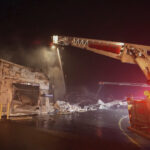So far since the Champlain Tower collapse in July 2021, two other condominium buildings have been inspected, failed, and evacuated (Crestview Towers and Bayview 60) in Miami, Florida. In the meantime, the Florida legislature failed to take definitive action to require any kind of inspection of aging large structures.
Whether you agree or disagree that legislative action is the best possible way to fix this problem is not important since the state couldn’t come to any kind of agreement on how to require these inspections. Even if it’s a good solution, it will be fall before the next iteration of the bill can go before a committee and the process starts all over again. Please refer back to Schoolhouse Rock, I’m Just a Bill…
At least Miami-Dade County has taken action to require that buildings get recertified (40 years after construction and every 10 years after that), which is how these other two buildings were identified and evacuated. While this may not be the best possible solution either at least something’s getting done. The county gets a little money and buildings get inspected.
This is an incomplete system and requires another partner in it, the insurance companies.
Given the current state of property insurance in Florida, it would seem to be a matter of survival for those insurers that are insuring any large structure in Florida, especially since many of them were first built 40 or more years ago.
Since insurance is built on the idea of analyzing and assessing risk, insurance companies should never take for granted that the risk that they took on is the risk that they are currently writing.
Early in my insurance days, as an underwriter for different states around the country, underwriting the property insurance wasn’t the biggest deal. It was generally a relatively low premium as a part of the whole and in most states at the time, the risks weren’t that significant, even when the limits were.
However, none of the buildings that I was underwriting were large condominium structures that includes dozens of living units, spread over five or more stories, standing on the edge of an ocean.
Insurers that are involved in writing insurance on large buildings such as these must begin to ask more questions, seek more documentation, write smarter policies, and price more aggressively. Most commercial insurers are going to ask some of the right questions. They want to know what construction materials were used in the building (frame, masonry, non-combustible, etc.). They will also ask when the building was built. Depending on the age of the building, they may ask when the last time the roof, the HVAC, electrical, or plumbing were replaced or updated. They’ll also ask questions about the occupancy of the building, how often there are short-term rentals and how much of the building is used for short-term rentals.
Even the homeowners’ insurers might ask some of those questions, maybe. Some of the insureds might be using the latest and “greatest” app-based insurance product, which promises to write an insurance policy for them within 12.5 seconds without asking a lot of questions. We know that they are going to rely on the public data that are available to them, whether or not that’s complete or accurate is another story. They also rely on their marketing that they are charging significantly less than other companies will so there’s that, too. We will find out how that worked out for them in their next round of funding.
All in all, there is a human toll on these problems. If the buildings aren’t properly inspected and cared for, the people who suffer the most are the people who live in them. At best, nothing happens and they live their lives enjoying the Florida condo life (whatever that means). Lately, it means that they get a phone call at work telling them that they have 24 hours to gather up as much as they can because their building is dangerous, but don’t worry, we’ll give you $150 for up to three nights in a hotel in Miami (hint: you probably don’t want to stay in any hotel in Miami that you can stay in for $150 for three nights). And we know what the worst-case scenario looks like. This is why I look at this as a problem where insurance companies can help make these risks better. Here’s the plan.
Ask better questions.
There’s only so much information that you can glean from the standard property questions. Don’t get me wrong. We need to know how big the building is when it was built, and its construction class. We need to know what’s going on in the building. It’s good to know if there are sprinklers or fire alarms in place. Finding out when the sprinkler system was last purged or tested isn’t a bad question, either. But when we’re dealing with multimillion-dollar buildings housing dozens (if not hundreds) of families, you need to get things right.
It isn’t enough to know what it was built from. You need to be asking questions about maintenance records. Have there been any signs of settling or cracking? Have there been any emergency maintenance issues that caused any part of the building to be shut down, closed off, or evacuated? Is there a parking structure under the building, or under the pool? Who were the developer and general contractor when it was built?
There are some questions that you should ask the internet as well. I remember back when I first became an underwriter that we were told not to rely on the internet for underwriting decisions. That just isn’t the case anymore. There is more reliable information available online than ever before. Even if the information isn’t fully reliable, looking at it and asking the insured about it will help to guide decisions and build a better underwriting profile of the individual building.
The internet will tell you when the last permit was pulled for the building and what it was for. There are more permits than just replacing or repairing a roof. The internet will tell you what former residents have to say about the association or management company that runs the place. Again, maybe it’s fully reliable. Maybe it isn’t. But when you can show the insured that they have 75 reviews online that all say that there are maintenance issues in the building, they at least have to answer as to whether or not that’s true and why.
Get better inspections.
Commercial buildings require different inspections than single-family dwellings do. It’s more than just a four-point inspection. We aren’t just looking to make sure that the roof doesn’t leak, how old the HVAC is, or when the last time the plumbing or electrical were upgraded. It needs to be about what condition the whole building is in. That might mean going the extra step to have an engineer inspect the building.
In 1866, the Hartford Steam Boiler Inspection and Insurance Company opened its doors to inspect and insure steam boilers. Those inspections have served as both the basis of ensuring the insurability of the steam boilers (these days, it includes other equipment in an equipment breakdown policy) and getting the required inspections of those machines. The inspection for the insurance company served to meet a local requirement.
The insurance company can coordinate the inspector, who performs an inspection that would meet the requirements of any state or local law requiring a certification of the structural integrity of the building. If the building doesn’t pass, it doesn’t get insurance and it doesn’t get its certification by the city, county, or state.
Do more frequent inspections.
Miami-Dade County has an ordinance that requires the first certification of a building after it’s been standing for 40 years. Perhaps it’s worth considering shortening that time frame. Buildings can change in 20 years, especially if the building has been neglected at all, including any deferred maintenance.
Once that initial inspection is done, don’t wait 10 years. This should be done in five-year increments. More frequent inspections means that there are closer eyes on potential problem areas. Some part of buildings, like support pillars under a pool, or in a parking garage can be watched closely so that rather than having an emergency in 10 years, there is something that needs to be watched closely.
If an item is identified at an inspection as a watch item, that gives the association time to find out what’s really happening, what it will take to fix the problem, and how much that will cost. Before an emergency happens, you have the information that you need to follow up at the next inspection.
Also, make those inspections public information so that when the insured decides to change insurance companies, the new company will have access to the past inspections so that they can follow up on the deferred maintenance or trouble spots that were reported in the last inspection.
Charge more money.
No one wants to hear it, but can we just be honest with each other for a minute? Sometimes underwriters and agents have conversations about the cost of insurance and the goal is to get the insured to pay less for more coverage. I get it. No one likes to pay more. But when you consider that we are dealing with large buildings that appear to have a higher risk of something going wrong with them, we have to consider the possibility that we’re just not charging enough.
There’s a bit more to the conversation than just charge more. I get that and not every risk needs to be charged as much more than other risks. I understand that Florida has some of the highest insurance rates in the country, but that’s because of the unique insurance needs here. We need to find that place of balance where the correct premium is charged for the risk assumed.
I’m not 100% for everyone paying more for their insurance, but with one building collapsed and two others evacuated because they failed a safety inspection, that’s a pattern. Until there is a significant effort to get buildings inspected and certified as still safe after all these years, all uninspected buildings need to pay a higher premium.
That does three things. It motivates building owners to get their buildings inspected (and pass those inspections) quicker. Knowing that their insurance company is charging them a 35% higher premium because their building is 45 years old and doesn’t have a safety certification on file might just make them request the certification.
If a building owner knows that their deferred maintenance might cost them an extra 40-50% in insurance premiums, that might motivate them to handle their maintenance rather than defer it. If condo unit owners or tenants are required to pay similarly high insurance rates for the same reason, they are going to apply pressure to the building owners to get the inspections and repairs done.
Expand coverage.
The other side of the coin when we raise rates is that we need to give insureds something for those higher rates. So rather than some piece of junk, like the little paper calendars with magnets, how about something meaningful, especially for those risks that end up paying more because the whole market is artificially deflated.
One area of coverage that could stand to be broadened is in Loss of Use. Loss of Use coverage applies to homeowners’ type policies. We would be looking specifically at the ISO HO-6 (or equivalent). Here’s how we start to determine if there is coverage for the Loss of Use.
If a loss by a Peril Insured Against under this policy to covered property or the building containing the property makes the “residence premises” not fit to live in, …
So the key is to determine if there has been any damage by a peril insured against. In the case of a building being deemed unsafe by a certification inspector, there may not have been any damage yet. If there was damage, then the insured would need to show that the damage occurred because of one of the Perils Insured Against, which is a list of 16 named perils. Spoiler: deemed unsafe by inspection is not on the list.
If you like to read policies, you might be familiar with a paragraph labeled, Civil Authority Prohibits Use. That might be a good place to look, but don’t get your hopes up. Here’s the sentence.
If a civil authority prohibits you from use of the “residence premises” as a result of direct damage to neighboring premises by a Peril Insured Against, we cover the loss as provided in 1. Additional Living Expense and 2. Fair Rental Value above for no more than two weeks.
So, yes. There is coverage if a civil authority requires the residents to move out, but that coverage is limited to times when a neighboring building is damaged by a Peril Insured Against, which also doesn’t cover the idea that the city forced people out because their building was unsafe.
For the additional premium that we already discussed, lets expand the Civil Authority Prohibits Use coverage to something like this.
If a civil authority prohibits you from use of the “residence premises” as a result of direct damage to neighboring premises by a Peril Insured Against, or as a result of the building’s failure of any certification inspection, whether mandated by the civil authority or by any insurance company insuring the building, we cover the loss as provided in 1. Additional Living Expense and 2. Fair Rental Value above for no more than four weeks.
This new wording (or similar wording) would give the residents help for an unforeseen event (they can’t live at home because their building isn’t safe) for a period of time that’s long enough to find out how long they won’t be able to live in their homes and make informed decisions about what they want to do next. Four weeks won’t be enough to cover the time needed to repair the building, but it does give them more coverage then they currently have, which is none.
Coordinate coverage layers.
It’s possible that some companies won’t want to cover the whole building. Who wants to insure a $100 million structure that might collapse because there hasn’t been proper inspections or maintenance in the last 20 years? That’s right. No one does. That’s not really accurate, because there are some carriers that will write them, especially when they take my advice and get hard on their underwriting and pricing. So if there are primary and excess property policies in place, they should all share in at least a portion of the available information, which should primarily include recent imagery and inspection data.
History tells us that back in the day, fire departments were departments and divisions within the fire insurers. Their jobs were to protect the buildings that the insurer was covering. It was a help to the customer and to the company. It’s time to consider more ways that companies can help to mitigate risk, rather than simply financing risk.
Was this article valuable?
Here are more articles you may enjoy.



 Global Q1 Commercial Insurance Rates Drop 3%, but US Casualty Bucks the Trend
Global Q1 Commercial Insurance Rates Drop 3%, but US Casualty Bucks the Trend  NJ Wildfire Update: 50% Contained; High Spread Risk Today; Suspect in Custody
NJ Wildfire Update: 50% Contained; High Spread Risk Today; Suspect in Custody  Wildfire Losses Drop Chubb Q1 Net Income 38%, While Tariffs Create ‘Confusion’
Wildfire Losses Drop Chubb Q1 Net Income 38%, While Tariffs Create ‘Confusion’  State Farm Wins Dismissal of Class Action Over Xactimate Software
State Farm Wins Dismissal of Class Action Over Xactimate Software 


